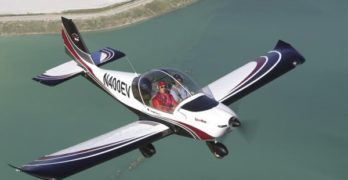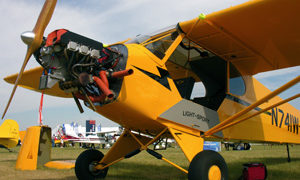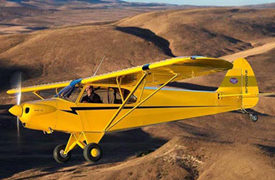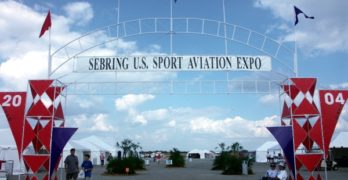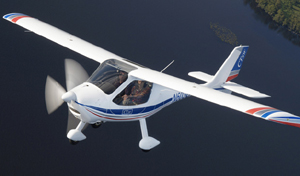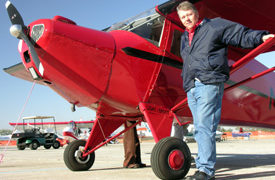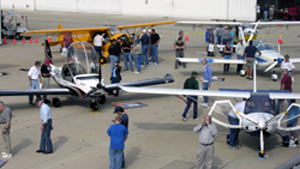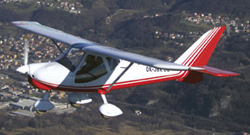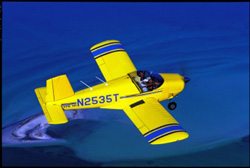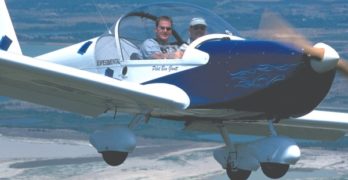Being first is often good in marketing, sports, or life in general, for that matter. In the light-sport aircraft (LSA) certification race, one aircraft has already won: the Czech Republic-built Evektor SportStar. This all-metal, low-wing, bubble-canopy design was the first aircraft to win its airworthiness certificate as a special LSA (S-LSA), and no one can ever take that distinction away.
Evektor Aerotechnik appointed Sport Aircraft International of Kerrville, Texas, as its American distributor. That company is currently in the process of transitioning to Evektor America as its new trade name. At EAA AirVenture Oshkosh 2005, it exhibited a beautifully finished SportStar SE alongside Evektor’s four-seat Cobra, which is aimed at the Cirrus market. In the LSA Mall, another SportStar presented itself to thousands of visitors.
I flew the first imported version of the SportStar, then called the EuroStar, a few years ago. The day after EAA AirVenture 2005 ended, I was delighted to join Evektor America President Jeff Conrad and rocket down Wittman Field’s runway in the newest SportStar SE (special edition).
Search Results for : Texas aircraft
Not finding exactly what you expected? Try our advanced search option.
Select a manufacturer to go straight to all our content about that manufacturer.
Select an aircraft model to go straight to all our content about that model.
Legend is First Cub to Sport a Jabiru Engine
Legend Aircraft‘s Cub is one of the top selling SLSA, ranking up high with Flight Design’s CT, Fantasy Air’s Allegro, Evektor’s SportStar, and TL Ultralight’s StingSport. Both American-made Cub-like designs (Legend’s and CubCrafters‘) have been 100% Continental O-200 powered because that engine is close to what was used in the original Piper J-3 Cub, which has driven demand from customers attracted to the vintage aircraft. However, the Cubs have higher empty weights than many of their smaller metal or composite competitors — CT and StingSport, being primarily carbon fiber airframes, weigh in almost 200 pounds lighter, for example. So, when operating at higher elevations or on floats, reported Legend staffer Pat Bowers, some owners felt more power would be useful. For several weeks the Sulphur Springs, Texas factory worked to install the Jabiru 3300. The six cylinder engine is 35 pounds lighter and has 20 more horsepower, a combination said to provided spirited performance.
CubCrafters Sport Cub Becomes SLSA #37
CubCrafters, builder of the Part 23 Top Cub, won their SLSA airworthiness today, becoming SLSA #37 to make their Statement of Compliance under ASTM consensus standards. The Washington state company brings the third J-3 Cub-like product to the market following Texas-based Legend Cub and the Zlin Savage from Italy. CubCrafters’ version follows their conventionally certified Top Cub and the company prides itself on building the Sport Cub CC11-100 on the same assembly line, which some buyers will value. AirFleet Capital, EAA’s official aircraft financing partner, is willing to finance a Sport Cub over a 20-year period (longer than other brands) because it is built on a Part 23 production line. Sport Cub is powered by the 100-hp O-200 Continental engine (as is the Legend Cub, though that company is also working with the Jabiru 3300) which allows the CubCrafters’ model to cruise at 105 mph (91 knots).
Sebring 2004: First Impressions
The U.S. Sport Aviation Expo in October 2004 was the first event to focus exclusively on Light-Sport Aircraft.
ou never get a second chance to make a first impression. With that in mind, you might ask how visitors regarded the first U.S. Sport Aviation Expo, held in Sebring, Florida, from October 28-31, 2004. The Expo was the first of its kind aiming at the new Sport Pilot/Light-Sport Aircraft (LSA) segment, and it was a focused event, featuring only LSAs and ultralights. Is that two strikes against it or two good reasons for it to succeed?
From what I could see, those who attended the Sebring event were satisfied. Set aside for the moment reports elsewhere that the show was sparsely attended. It was the first of its kind. And as word of mouth is accepted to be the best marketing tool for shows, the attendance figures should present no surprise. The vendors were satisfied, and visitors also seemed to feel good about the selection of aircraft, the availability and ease of demo flights and the wide array of educational forums.
Gearing Up for a Big Year of SLSA Sales
Recently at least four companies have announced their expansion plans and more have certainly been working similarly but not made their plans public. I’m only guessing here (while we wait for federal N-number registrations to catch up to reality)…but I’d say deliveries of SLSA may have numbered 500 aircraft in 2005. While that’s a healthy start, 2006 appears to be a year for LSA to fill the skies far more. Flight Design announced plans to approximately double output of their market leading CT to over 200 aircraft (half of which will come to the USA). TL Sport Aircraft is preparing to quadruple production of their StingSport. FlyItalia-AveoUSA is adding a much larger factory for 150 workers. And Texas-based Legend Aircraft is building a new plant to substantially increase deliveries. With these and others planning to build many more planes plus new providers coming online, we could see 1,000+ deliveries in 2006.
Can An Oldie Be a Goodie…as a LSA?
I find it ironic that our first new SLSA certification of 2006 is one of the oldest. Welcome to the Taylorcraft Sport as Number 24 in our parade of newly FAA-approved Special Light-Sport Aircraft. A bright red Taylorcraft Sport showed at the Sebring U.S. Sport Aviation Expo last week after winning its approval on January 9th. The taildragger Sport comes with a Continental O-200 100 horsepower engine and without flaps for $69,995, a fairly modest price in this time of Light-Sport Aircraft hitting six figures. Taylorcraft has a rich historical background, starting in 1935 and including a run of thousands of aircraft built. In mid-1946 the company was producing 30 new aircraft a day!…so many that, even today, the majority of Taylorcrafts flying are from that year. Now, buyers can obtain a brand new Sport from the revived company.
Dallas TX Sport Pilot Tour a Big Success
The fourth of six Sport Pilot Tour “test” events proved the idea has great appeal as a means to reveal all the new Light-Sport Aircraft and to educate those who attend about FAA’s newest rule. The Dallas, Texas Sport Pilot Tour concluded with 11 models represented. Crowds were the strongest yet with 750 people attending; these are intended as focused, small-venue marketing efforts that only show LSA and offer expert forums on the topic. EAA is solidly behind the events using their national clout plus local EAA chapters in nearly every corner of the country. Many demo flights were taken, even expanding into Sunday following the Saturday event. All Sport Pilot Tours are free to visitors. The next one, scheduled for December 3rd in Camarillo, California (near Ventura) promises to be the biggest yet. “Join us,” says EAA and many aircraft exhibitors. “C’mon out and see the newest airplanes!”
SportRider Wins SLSA Approval
After a short lull in new approvals, the first to announce winning FAA’s blessing following AirVenture Oshkosh 2005 is AveoUSA’s SportRider. Designed by Jaro Dostal, the same man who created the comfortable SkyBoy, SportRider is built by Gryf Air of the Czech Republic and handled by FlyItalia. Sport Rider is sold in America by Texas-based AveoUSA. Once folks returned home from EAA’s big show this year, I got several emails from pilots asking about this handsome aircraft with its flowing lines and 46-inch-wide cockpit. You can see my early report in the August 2005 Kitplanes magazine and I hope to do a pilot report this fall, perhaps on one of the EAA Sport Pilot Tours where you can also go for a demo flight.
More S-LSA Approved by FAA
IndUS Aviation of Dallas, Texas received FAA approval for their Thorpedo model as a Special-Light Sport Aircraft. IndUS is the first U.S.-based manufacturer to earn a S-LSA certificate; the company takes airframe components fabricated in India and assembles them at their Texas facility. IndUS can now sell fully built LSA that can be used for paid flight training or rentals. (My review of this aircraft is available here.) For more info go to the IndUS website. Two other companies have also received approvals recently. SportAir USA was issued a certificate for their StingSport just before Hansen Air Group got their approval for the Tecnam Sierra.
Star in Your Sky
The expression “seeing stars” is a good thing, if it means flying a delightful aircraft on a lovely day. After sampling the Sportstar in ’02 (see “Sportstar Pilot’s Report”, December ’02 Ultralight Flying!), I looked forward to a flight in its predecessor, the EV-97 Eurostar. You could say I had stars in my eyes. A blue Florida sky was dappled with miniature cumulus clouds, winds were mild, and the fuel tanks were full in a pretty blue-and-white Eurostar. I was ready.
On a beautiful Saturday, April 17, I flew the Evektor Eurostar with Nick Motlagh (pronounced “MOTE log”) – a sharp young aviator about to embark on a career in the air. He has been accepted to compete for fighter jet training in the Air Force after graduating from Embry Riddle Aeronautical University in Daytona Beach, Florida.
Motlagh had flown the Eurostar (N30167) over to South Lakeland Airpark to allow a flight review.


